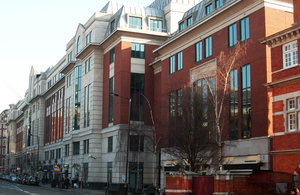Local authorities given further support to make roads safer
Updated speed limit guidance published for consultation.

Updated speed limit guidance to help local authorities improve safety on their roads was published for consultation today (13 July 2012) by Road Safety Minister Mike Penning.
The guidance provides up-to-date advice to aid greater consistency of speed limits on local roads across England. It incorporates recent changes that have increased flexibility for local authorities to implement 20 miles per hour (mph) limits and zones where it can be shown that they benefit road safety and quality of life.
It also gives authorities more information about the new speed limit appraisal web tool which will help authorities fully assess the impact of any change to a speed limit in their area.
Road Safety Minister Mike Penning said:
It is vital that speed limits are suitable for local conditions and councils are best placed to determine what these limits are, based on local knowledge and the views of the community.
To help, we are publishing updated guidance for consultation. This includes a number of initiatives we have introduced to improve road safety, including making it easier for local authorities and communities to put in place 20 mph schemes, or use common sense measures such as variable speed limits outside schools.
Road safety is a top priority and the guidance - along with the speed limit appraisal web tool - will help councils make evidence based decisions to introduce local speed limits that reflect the needs of all road users.
The revision of the guidance and the introduction of an economic tool to help authorities assess the full costs and benefits of any proposed schemes were a commitment in the Department for Transport’s Strategic framework for road safety published last year.
The guidance is aimed at local authorities in England. The final guidance is expected to be published by the end of the year.
The web tool, also to be launched later this year, is being developed with input from road safety groups and local authorities.
Notes to editors
This guidance is to be used for setting all local speed limits on single and dual carriageway roads in both urban and rural areas. Local traffic authorities are responsible for determining speed limits on the local road network.
The objectives of this guidance are:
- the provision of up-to-date and consistent advice to traffic authorities
- improved clarity which will aid greater consistency of speed limits across the country
- enabling the setting of more appropriate local speed limits, including lower or higher limits where conditions dictate
- achieving local speed limits that better reflect the needs of all road users, not just motorised vehicles
- ensuring improved quality of life for local communities and a better balance between road safety, accessibility and environmental objectives, especially in rural communities
- improved recognition and understanding by road users of the risks involved on different types of road, the speed limits that apply, and the reasons why
- improved respect for speed limits, and in turn improved compliance
- continued reductions in the number of road traffic collisions, injuries and deaths in which excessive or inappropriate speed is a contributory factor
The key factors that are taken into account in any decisions on local speed limits are:
- history of collisions, including frequency, severity, types and causes
- road geometry and engineering (e.g. bends, junctions, barriers)
- presence of vulnerable road users
- road function
- existing traffic speeds
- road environment, including level of road-side development and possible impacts on residents (e.g. severance, noise, or air quality)
We are not seeking views in this consultation on the national limits of 30 mph on street lit roads, 60 mph on single carriageway roads and 70 mph on dual carriageways and motorways.
Press enquiries: 020 7944 3108
Out of hours: 020 7944 4292
Public enquiries: 0300 330 3000